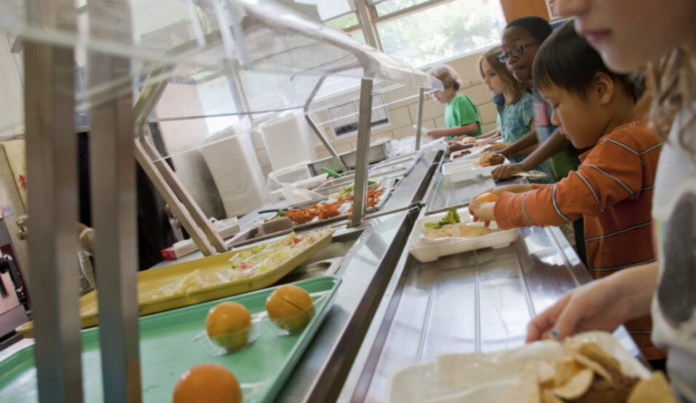
By Casey Smith
Indiana Capital
INDIANAPOLIS — Thousands of Hoosier kids are missing out on free breakfast and lunch, even though nutrition advocates say many Indiana families continue to struggle with hunger and food insecurity.
That’s according to a new report by the Food Research & Action Center (FRAC), a national nonprofit that aims to reduce poverty-related hunger.
FRAC’s report indicates that nearly 58,000 fewer children in Indiana received a lunch on an average day in July 2022, a decrease of more than 50% from the previous summer. Data for 2022 is the latest to be released.
Participation rates for breakfast fell even further as 60,000 fewer children received breakfast on an average day in July 2022, a decrease of about 81% compared to July 2021.
The decline in participation follows previous increases in summer meal participation in 2020 and 2021.
Across the country, every other state also saw a decrease in the average daily participation in summer lunch in July 2022 compared to July 2021, according to FRAC.
As we’ve returned more to normal operating procedures, we just don’t have the ability to reach as many kids with as many meals.
Child nutrition waivers issued by the U.S. Department of Agriculture make the free meals available at summer meal sites, oftentimes located at schools and community centers.
While waiver access was expanded during the COVID-19 pandemic, eligibility restrictions are back in place, meaning fewer kids can access free meals.
“During the height of the pandemic, families could drive through summer meal sites and pick up multiple meals for a few days, making the process a whole lot easier for many,” said Emily Weikert Bryant, executive director of Feeding Indiana’s Hungry, an Indianapolis-based nonprofit focused on increasing Hoosiers’ access to food. “As we’ve returned more to normal operating procedures, we just don’t have the ability to reach as many kids with as many meals.”
Although state and federal officials have piloted new programs to get additional kids fed, Bryant said many still lack access to nutritious foods.
“Congress addressed this with a couple of new options that were piloted and developed during the pandemic but they seem unlikely to address child nutrition programs again soon,” she continued, emphasizing that “summers add an extra level of hardship for families at risk of hunger.”
Summer meal options
The two federal summer nutrition programs — the Summer Food Service Program (SFSP) and National School Lunch Program (NSLP) — provide funding to serve meals and snacks to children at sites during summer vacation or the extended breaks of year-round schools. The programs also can be used to feed children during unanticipated school closures.
The SFSP is a federally-funded, state-administered program that reimburses approved program operators who serve free, healthy meals and snacks to children under age 18 in low-income areas when school is not in session.
Sponsorship is open to public and private nonprofit groups, including local governments, summer camps, religious organizations and recreation centers. Organizations may also consider partnering with an existing sponsor, such as a school corporation, to serve students in areas where kids lack good nutrition during the summer months.
Separately, the NSLP is available for schools that operate summer school. Only the students enrolled in summer school can receive a meal, however.
The FRAC report indicates the number of SFSP sponsors and sites decreased from July 2021 to July 2022.
Specific data obtained by the Indiana Capital Chronicle from the Indiana Department of Education shows there were 280 sponsors and 2,035 sites statewide that provided summer meals in 2021. That decreased to 192 sponsors providing summer meals at 1,047 sites in 2023.
FRAC experts and state officials attribute much of the decrease in participation to the reintroduction of limitations on summer nutrition programs.
Prior to the pandemic, to qualify as a summer meal site, at least 50% of the children in a given geographic area had to be eligible for free or reduced-price school meals, or at least 50% of kids participating in the program at the site had to be individually determined eligible for free or reduced-price school meals. Sites that primarily served migrant children also qualified.
Once a site was determined eligible, all children who come to the site can eat for free, regardless of their economic or migrant status.
Through the program, a sponsor enters into an agreement with the state education department to run the program and receives reimbursement for each eligible meal and snack served at meal sites.
That changed, though, during the pandemic — from Spring 2020 through Summer 2022 — when states could utilize a nationwide child nutrition waiver that allowed any community to have a summer meal site.
Although waivers were technically available for Summer 2022, Congress did not extend the waivers again until late June, which IDOE officials said was “too late” for Indiana’s SFSP operations.
This year, federal meal program eligibility returned to standard procedure, meaning only low-income areas were qualified to participate.
FRAC noted that program staffing shortages, supply chain disruptions and many meal sites shuttering as a result of the pandemic additionally led to fewer children receiving a summer lunch in 2022 and 2023.
Why are fewer kids participating?
FRAC’s goal is for all states to feed summer lunches to 40 kids for every 100 children who received free or reduced-price lunch in the 2021–2022 school year.
As of July 2022, just eight students in Indiana received a summer lunch per every 100 students who ate school lunches during the regular academic year, according to FRAC.
To meet the nonprofit’s goal, the Hoosier state would need to increase the number of students served summer lunches by more than 200,000: from 54,445 kids to more than 268,000. That equates to more than $19 million in additional federal reimbursement dollars for summer lunches.
Bryant applauded IDOE for a program piloted this summer that allowed additional meals sites in rural areas. Kids in certain parts of the state were able to access meals without having to be present at that site to eat the meal, “which is a big step toward increasing summer meals,” Bryant said.
“We need to see more of this — not just in rural areas — but anywhere, because we know it’s not just finding a location but getting to it each day to sit and eat the meal on site that can be difficult,” she added.
Bryant and FRAC also pointed to federal legislation adopted in December 2022, creating a permanent program that will provide an Electronic Benefit Transfer (EBT) card to purchase food during the summer months to families eligible for free or reduced-price school meals, extending the summer benefits families have received through the Pandemic EBT Program. The legislation takes effect next summer.
“It’s a great step forward because SNAP benefits don’t go up in the summer when kids are eating at home,” Bryant said. “These innovations, borne from the pandemic, will help more children access what they need when they’re out of school. What will be important going forward is insuring these programs are as accessible as possible by encouraging Congress and the administrating agencies to reduce barriers to program access, streamlining program administration to encourage more site and agency participation, and insuring the benefits are adequate to really be helpful.”
She said families can also access food banks and food pantries in the summer — or any time — for extra help stretching their grocery budget.
Still, FRAC is urging policymakers to improve summer meals access. At the state level, that includes better advertisement about summer meals to families, as well as more financial support for summer food sponsors to increase the number of available meal sites. More broadly, the hunger relief organization called on the federal government to lower the eligibility threshold from 50% to 40%, and to make permanently increase funding for summer and after school programs where meals can be served.
* * *
The Indiana Capital Chronicle is an independent, nonprofit news organization dedicated to giving Hoosiers a comprehensive look inside state government, policy and elections. The site combines daily coverage with in-depth scrutiny, political awareness and insightful commentary.
You can read the original version of the story here.




